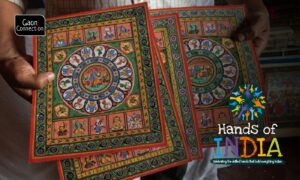It has been a lingering lockdown and a searing summer. As the world stills, and so does time, we have all turned inwards to our home. Home is safety from disease, home is sanctuary, but home is also a lack of connection to the outside world—a feeling of isolation.
But our home is not just ours. Without us knowing it, our home is the centre of a web of ecology. Gaps in the wall may be the site for a brood of chicks. The khus mats of our coolers may be the setting for wasp nests, and the material a bird carries away for her nest. There will be a spider under your sink, that eats mosquitoes for you, and a range of bees that come to the flowers outside. Each little grain of rice that falls on the floor may be carried off by an ant, to its little ant hill in the garden.
Your home is part of a bigger scheme of things. During the lockdown, I have watched home ecologies spinning, beating, and thriving. They have taught me that I am anything but isolated or alone. Even a single brood of chicks being raised by a Myna in the balcony, in the blazing heat and surprise showers, can hold in it a kernel of hope – that life is interconnected, and the circle of life is eternal. Here are five homes-within-your-home you should know about.
I don’t scream when I see a spider web. I tend to smile. It means a parallel house is running at home, with its own architecture, and its own delicate chambers.
Ant hills: when I was a child, I wondered what little brown mounds on the ground were. They looked like mountain ranges, undulating, rising, and speckled. Once, I saw such a brown mound on the marble floor of the balcony. It had a hole in the centre, and it looked like a floral arrangement. Still, I thought it was dirt and I brushed it away.
Over the next few minutes, what I saw amazed me. Scores of little black ants rushed to the spot. They scurried out of the hole, as if they were waves of water. They went to the place where I had brushed the dirt aside – dirt that was actually part of the anthill—and brought each little component back to their home. They communicated with each other using their feelers and placed bits of mud at precise locations, rebuilding the ant hill in a matter of minutes. That was the last time I ever disturbed ants – their patience, and their industriousness had won me over.

Bird nests: birds may often be nesting near your house, using scraps of paper, bits of cloth, and twigs to make their nest. But you can also help them by setting up nestboxes. An old shoebox may be converted into a bird nest, or you can make one out of wood. You have to make sure you secure it fast to the wall, so it doesn’t move, and that it is not in direct sunshine. This month, I have watched a Brahminy myna family raise their chick in my balcony. The nest box is now silent, and the chick is gone. The birds have more mobility than some of us; and the cycle of life moves forward.
This month, I have watched a Brahminy myna family raise their chick in my balcony. The nest box is now silent, and the chick is gone.
Spider-webs: watch an old horror movie, and spider webs are a favoured prop. Spider webs are associated with dust, decay and neglect. Yet, spider webs hold a little eight-legged creature that does a valuable pest control service for you. After the rains, insects come teeming in, and the spiders swing into action. If the spider you see has long legs, it is probably the ‘daddy long legs’ spider and is completely harmless. Their webs, shining silver, when not catching dust, ensnare insects like mosquitoes. I don’t scream when I see a spider web. I tend to smile. It means a parallel house is running at home, with its own architecture, and its own delicate chambers.

Bees: On a hot day, put water out, and watch bees and wasps come rushing to drink. we classify everything with a narrow waist and strong wings as a ‘bee’, but there are many kinds of bees and wasps that will frequent an Indian home. perhaps the most filmy and most famous is the bhanwra, large, dark purple, and a presence to behold. This is the carpenter bee, an aashiq (lover) of flowers. If bees come to your flowers, this is a certificate of non-toxic surroundings—a certificate that comes on wings, with a loud buzz.
You may not know it, but there should be a predator close to your house, eating mice, picking up pieces of meat from the garbage, and observing everything with eyes that miss nothing.

Carpenter Bee
Predators: you may not know it, but there should be a predator close to your house, eating mice, picking up pieces of meat from the garbage, and observing everything with eyes that miss nothing. Perhaps, your home provides sustenance for them. Black Kites are birds of prey that live in most cities. they will scavenge pieces of meat and fish, and also bring down small animals. Soundless Barn owls also live near people, taking out mice while you are asleep.

A Kite
This lockdown has been a time of grief, and also a time when people have stepped up as heroes, helping others as they can. Safeguarding the lives of other creatures is a way to know our own best selves, slow down, and see how you are connected to the rest of the universe. For truly, compassion begins at home.















